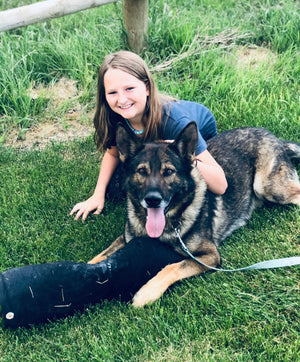Transfer of ownership from a grown dog’s point of view is best accomplished without the prior handler present. German Shepherd dogs with proper character resist performing for strangers while they are still attached to a handler. It is best to send them to their new owners by themselves, thereby expediting the bonding process with the new owner.
Going to the airport
Bring doggy treats (cut up chunks of hotdogs are a favorite) with you to the cargo department of the airline your new dog will arrive in. Give the flight details we provide you at the counter. When you approach the kennel, start talking to the dog in a friendly tone. Your new dog will be looking for familiar people and sounds. The sound of kind words in a friendly tone coming from you will automatically generate a beginning level of trust and is the first step in the bonding process. When you are ready to open the door of the crate, have a leash ready to snap on the collar. Be sure to get the lead on the dog as he comes out. Once you have the leash on the dog, the bonding process can really start as you now have a real and physical connection to the dog. All dogs know whomever is at the end of the leash has control, helping establish you as the pack leader immediately.
The person who first opens the crate door and attaches the lead is normally the first person the dog will give it’s trust to. After the dog has relieved himself, he/she should be returned back to the crate for the ride home, if possible. He/she will be more comfortable riding in the crate than being loose in the car. Every dog will need time to adjust to the new surroundings. The natural acclimation period will differ between dogs. Travel affects the dogs in the same manner as people. Some are very good travelers and acclimate quickly and others need more time to adjust. This period is commonly referred to as jet-lag. Try to arrange to have at least 48 hours that that you can dedicate to your new dog when it arrives. He/she needs quality time with you.
This is an important bonding time when your new dog is feeling most stressed and vulnerable in his new environment. Keep household activities and visitors to a minimum while your dog gets familiar with everything. Some will be more cautious and unsure of their new surroundings indicating that they need to be introduced more slowly into their new home.
Introduction to other pets must always be done on leash
Two dogs of the same sex can learn to get along with each other but it is much easier to introduce dogs of the opposite sex to each other. Try introducing dogs in a neutral territory (i.e. a park, parking lot, etc). For the first introductions, both dogs will need to be under your control on leads. They can approach each other on a loose lead but be prepared to separate them after one or two minutes. A few minutes later let them approach each other again. If all is going well, let them get to know each other for a few minutes longer. Remember not to force them to be together for long periods of time. It will take a few days to weeks, depending on individual personalities, for the dogs to work out a new pack order (establishing alpha, who’s dominant). Be patient, it may take a month for your first dog and your new dog to bond and truly enjoy each other’s company.
Cats and other animals
Two words sum up the best approach to introducing your new dog to other family pets: Slow and Careful. Be sure you’re there to make the first introduction in person and plan on supervising the subsequent get-togethers for at least the first week. You’ll need to show the dog that the other animal is important to you. Firm and with a strong command, tell your dog “no” at the first signs of chasing or intimidating the other pet. Expect to reinforce this for at least a few days with a correction from the leash and collar.
Territorial marking in the house
Before your new dog is brought inside, it is very important that you know he has relieved himself completely before bringing him into your home. After the long flight, he will need to eliminate so do not take the chance that he will have a strong urge to do so while he is in your home. Keep your eyes open and keep him on lead for the first time inside your home. Take your dog outside frequently to relieve himself, especially after eating. If your new dog does mark in the house, you did not watch him close enough to prevent it. Keep a very close eye on the dog until you feel secure that there will be no accidents.
Setting boundaries
New dogs have not established loyalties or attachments to you or your home. They might even be (geographically) confused. It could take a few days for him/her to learn the new turf. It’s best to keep your new dog on a lead or in a fenced yard when it is outside.
The new dog with children
Dogs have a unique relationship with people. As the understanding of the pack mentality becomes more prevalent, it becomes easier to see why dogs act the way they do. Understanding and altering dog behavior revolves around understanding dog’s behavior and the importance of dominance and submission in the dog psyche. It is important to remember that in the dog’s mind, the family is a pack unit and everyone in that family has a certain position in the pack. It will take some time to establish who are the members of the new family pack. It is very important in the first few days not to force the dog to spend too much time with the children. Excessive playing with toys and rough housing during the acclimation period will not create a comfortable atmosphere for the dog. Game playing such as tug-of-war, attempting to steal objects from the dog, and playing fetch should be limited in the beginning. It is essential that the parent understands pack order and the hierarchal relationship and takes precautions to prevent problems from arising.
Feeding the new dog
It is best to allow the dog to eat in private while he is getting accustomed to his new home. It is your responsibility to insure your dog has the opportunity to eat a healthy diet. Several good premium brand dog foods are available at pet stores. Grocery store food is not recommended; neither are table scraps. At Vom Berk Haus, we feed our dogs and puppies Life's Abundance All Life Stages dog food that it is nutritionally balanced & complete. More info can be found on our "Nutrition" page. Regular feedings once or twice daily is best and will also help control possible accidents in the house. Consistent bowel movements are a result of a consistent feeding schedule. Offering food that is not it’s regular diet may also cause digestive problems. Free feeding has no extra value and is not recommended.
Bonding
Working dogs are very loyal and are looking for someone to attach that loyalty to, their next handler. It usually takes anywhere from a day, up to a week for them to bond. Spend lots of time brushing, petting, and talking to your new dog. Go for walks on leash, and give lots of treats, it won't be long before you are their entire world!


